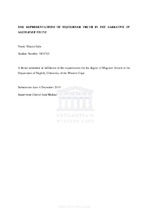| dc.description.abstract | I read representations of Sojourner Truth in her Spiritual Narrative, The Narrative of Sojourner Truth with a focus on the portrayal of her unconventional character, through a close analysis of language, structure, photographs and narrative voice. Truth’s editor Olive Gilbert’s raises questions about whether the daguerreotype offers a more accurate form of representation than text. I explore the similarities and differences between visual and written portraits in representations of Truth as a unique figure. I question critical readings of Sojourner Truth’s dress in photographs as conservative, reading instead for a combination of conservative and subversive elements. I suggest that her interest in aesthetic forms such as dress and décor is symbolic of her yearning for home, her heritage, her agency, and unique taste. Her many references to her family indicate that she was more than just an empowered figure, but also one who still grieved. I read Truth’s description of domestic space as representing ambivalently, both her sense of loss, and her attempts to acquire agency. I consider how Truth attempts to recreate a sense of family and belonging through fragments of memory. In my reading of how she questions and extends conventional notions of family and community, I explore how she adapts and includes song, and quotations from the Bible in her sermons, by drawing on elements of African folktale and music. Most critics focus on Truth’s strong voice as an activist, there is little attention to the significance of spiritual solitude for her reimagining of community. I suggest that Truth offers alternative ideas of community as fluid rather than as fixed in one place. I explore how her ideas challenge the notion of nation as exclusive. I consider the genre of The Narrative by analyzing Olive Gilbert’s role as editor and writer. I propose that her role in The Narrative is a more complex one than suggested by critics, as it challenges conventional concepts of autobiography creating a conversation between two voices and lives. | en_US |

